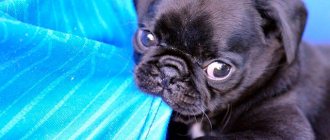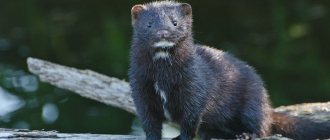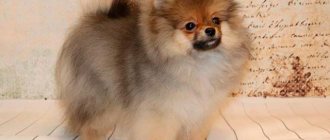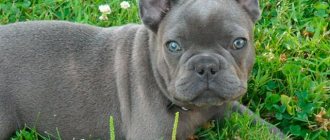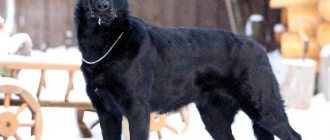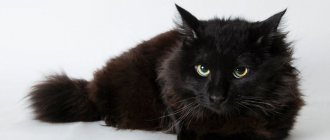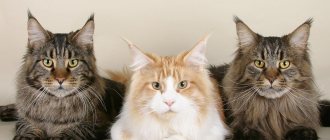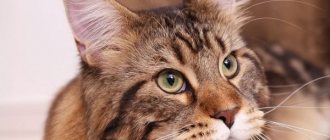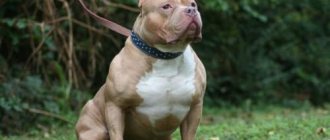The Maine Coon, with its black coat, stands out among its relatives. This is determined by its spectacular and mystical appearance, which fascinates animal lovers. The price category of such babies is higher than that of other colors. However, it pays off, since the nature of the pets is gentle and friendly. The cat requires attentive attention from the owner, for which he pays with boundless love and loyalty.
Description and features of an exotic feline
Maine Coon varieties depending on patterns
The classic version of the animal has a uniform black shade of fur without additional colors. However, there are often representatives of the breed that have a variety of patterns, clearly visible on the face and neck. According to the type of these inclusions, there are the following Maine Coons:
- Brindle. Vertical stripes run along the surface of the animal's entire body, as well as its tail and paws.
- Marble. Dark stains are located on the sides of the pet, which resembles a marble structure.
- Spotted. Stripes are clearly visible on the cat's fur.
Black and white Maine Coon
Animals are classified according to the location of inclusions of a different color. In accordance with this factor, the following are distinguished:
Maine Coons are usually classified according to the factor of inclusions in the color of a different color, for example, Van - only the head and tail are black.
- Medallion. The spot is located on the animal's chest, like a precious decoration.
- Gloves. The pigmentation affected only the paws.
- Bicolor. Uniform ratio of two colors throughout the pet's body.
- The tuxedo. A light-colored “shirt front”, usually located on the sternum, protrudes in combination with gloves.
- Harlequin. The initial undertone of the fur is white, on which there are splashes of black.
- Wang. The entire skin is white, except for the head and tail.
- Black smoke. The base of the hairs is white and the end is black. There are no stripes or stains on the Maine Coon's body.
Black Maine Coons often suffer from polydactyly, so their paws can have 6 toes.
Varieties of cat color
Black is the most valuable coat color of Maine Coons. Despite its apparent simplicity, it is never boring and a black cat cannot go unnoticed. It is also interesting that the variety of colors based on the black color of the coat is so great that even an inexperienced eye can see the absolutely individual features of the appearance of these cats. Below is a brief description with photos.
Solid
The basis of the black solid color (English solid - solid, solid) was obtained thanks to breeding work. This is a rare color for the Maikun, in which the coat of a representative of the breed is solid black. Hairs are the same color from roots to ends; spots or stripes of other shades are not acceptable. The eyes of these Maine Coons are most often reddish-copper.
Solid black color is not easy to achieve and maintain, which is due to the tendency of animal colors to combine several shades. The color of the coat is formed due to several pigments: eumelanin is responsible for black, pheomelanin for brown and red.
Coat color is passed on from mother to son.
Marble
With this color, dark lines are clearly visible on the sides of Maine Coons, reminiscent of stains on marble. There are dark spots inside the “marble” rings. Also, a pattern in the form of marble stains may be present in black-smoky cats, in which case the color is called black marble on silver.
Smoky
Smoky representatives of this cat breed have white hairs at the base, darker in the middle, and black at the tips. This color can be of several types, which depends on the haze parameter, determined by how much of the hairs are colored white:
- chinchilla – black color on the hairs occupies ⅛ of the length;
- smoky – the ratio of white and black colors on the hairs is 50/50;
- shaded – Maine Coon hairs are one third or one quarter black.
The fur at the roots should be white, not gray; the presence of spots or stripes on the fur is not acceptable.
brindle
The brindle (Mackerel) color suggests the presence of vertical stripes on the main black coat of the Maine Coon, located on the body, paws and tail.
Black and white
Obviously, the name of the color indicates that the coat of the Maine Coon contains both black and white colors at the same time. However, depending on their ratio and pattern of arrangement, black and white colors come in several types:
- buttons - there are several small spots of white on the black wool;
- medallion - there is a white spot on the chest that resembles a decoration;
- gloves - the whole body is covered with black wool, but the paws are white;
- tuxedo – the paws and shirtfront on the pet’s neck are white;
- Harlequin - on the main white color of the coat there are black inclusions of different shapes and sizes;
- Van - black fur on the head and tail, the rest of the body is white.
If the ratio of white and black colors on a cat's coat is 50/50, this color is called bicolor.
Character and behavior of a four-legged pet
Because of its size, the black Maine Coon is often mistaken for a dangerous animal, but first impressions are deceiving. This pet has a peaceful disposition and is suitable for couples with children. The cat has a playful character and often gets into funny situations due to its size. The pet requires attention from the owner, so it is not recommended for constantly busy people to have a Maine Coon. Lack of care can lead to animal apathy and poor health. Treats all family members with love, but may be wary of guests and not show attention to them.
What are the conditions for keeping the animal?
When deciding to adopt a large pet into the family, you should take care of creating a suitable corner in the house. It is best to consult with breeders which hygiene and interior items are ideal for the needs of a black Maine Coon. The cat will feel better if the owner takes care of the following things:
| Adaptations | Recommendations |
| Bed | Selected taking into account the active growth of the animal or specialized models are purchased |
| scratching post | Must support the weight of the pet and correspond to its dimensions |
| Toys | Models must be safe and do not contain beaded or button embellishments. |
| Soft balls and mice will be a winning option | |
| Tray | It is recommended to give preference to wide ones without high sides |
| Completely closed ones are not suitable, as the animal will not fit in it. | |
| Filler | It is better to choose a brand of litter that the cat is accustomed to in the nursery. |
| A bowl | Animals are better served by bowls made of glass, ceramic or steel rather than plastic. |
In pedigrees, exhibition catalogs and breed descriptions you can find abbreviations of letters and numbers that are incomprehensible to beginners. Let's try to understand these designations using an example, and also look at the most common colors of Maine Coons. So if you see something like MCO n22, what does it mean? The first three capital letters are the breed designation. For example, PER – Persian, ABY – Abyssinian, BRI – British Shorthair, etc. Accordingly, MCO means that we are talking about the Maine Coon breed. The next lowercase letter indicates the color of the cat's fur. Since there are quite a few acceptable colors for Maine Coons, the letters can be very diverse. For example: w – white – white; n – black – black; a – blue – light blue; d – red – red; e – cream – creamy; f - tortoiseshell - tortoiseshell (normally occurs only in cats, since it is determined by the simultaneous presence of genes responsible for black and red color; the gene responsible for red color is associated with sex and is located on the X chromosome; in cats, therefore, in the only the existing X chromosome can only have one or the other gene, a cat can have both, which leads to tortoiseshell coloration; in cats, the color can only arise due to genetic disorders leading to the presence of an extra chromosome (XXY), and such cats are infertile); g – blue-tortie – blue-cream (the same principle as the tortoise, but with a weakened color). If there is only one such lowercase letter, it means that we are talking about a solid color (solid) - the cat’s fur is evenly colored along the entire length and throughout the body. Sometimes a lowercase s – silver – silver may appear next to it. For example: MCO ns. Silver color means uneven coloring of the hair along the length. After the lowercase letter indicating the color of the coat, numbers may appear that indicate the pattern on the animal's coat. Tabby colors lead to the appearance of a characteristic dark letter “M” on the animal’s forehead, which suits Maine Coons so well, as if specifically emphasizing the breed. So, in our initial example MCO n22, the number 22 means blotched, marble: lighter rims on the eyes, the letter M on the muzzle, wide streaks on the sides in a circle, stripes along the ridge, spots on the belly and ring-shaped streaks on the tail and paws. Tiger color - 23 (mackerel, tiger) - is a pattern of continuous vertical stripes, like a tiger or mackerel (aka mackerel), which is reflected in the name of the color. Spotted Tabby - 24 (spotted) - appears as small spots or intermittent stripes all over the body. The color code may additionally include the designation of white spotting - 09. For example, MCO n 22 09 - black marbled with white color.
Consider the variety of colors of the Maine Coon breed:
Tabbies
If your cat has stripes, then his pattern is “tabby.”
(sometimes they say
“tiger”
).
All tabbies have fine lines on their muzzle that define their eyes and form an "M" on their forehead. If you look at the fur close up, you can see that each hair is colored with dark and light stripes. This alternation is called "Agouti"
.
It is generally accepted that tabby is the original color of wild, undomesticated cats. There are four main tabby
:
- Mackerel tabby (brindle)
- a pattern in the form of parallel vertical stripes. - Classic tabby (classic)
- wide spiral stripes on the sides, reminiscent of marble stains.
In the UK this pattern is called "blotched tabby"
. - Spotted tabby - (spotted)
. Spots throughout the body in the form of intermittent stripes. - Ticked tabby
- sometimes called Abyssinian or agouti. Without stripes or spots on the body, but with a pattern on the face and agouti on the body. This color is typical for Abyssinian cats, but it also occurs in other cats. Ticked colors are not recognized in the Maine Coon breed.
Tabby
come in a wide variety of colors.
Tabby color refers to the color of the stripes or the tip of the tail. The main color of agouti
varies from faded blue to deep red.
Brown classic tabby (black marble
) Wide
spiral stripes on the sides, reminiscent of marble stains. Black stripes on a brown background.
Brown spotted tabby ( black
spotted )
Brown mackerel tabby (black brindle)
Blue classic tabby ( blue
merle )
Red classic tabby ( red merle)
Silver
classic tabby ( silver marble)
Silver marble ( silver tabby)
- black stripes on a white background. The roots of the hair are white. Blue silver, cream silver, or red silver, cameo tabbies are also possible, depending on the color of the stripes. In any case, the silver tabby has a pale base color and white hair roots.
R ed
silver classic tabby (red silver marbled)
Silver
mackerel tabby ( silver brindle)
Cream classic tabby ( cream
marbled )
Solids
If your cat is all the same color, then it is “solid”
.
The British can call its color and “self”
.
Most solid colors have been developed by suppressing recessive tabby
.
Sometimes the pattern is not completely suppressed, then a vague shadow
tabby is visible.
If you have seen a black leopard, you may have seen the outline of the pattern because the leopard also has similar suppressed genes. Red
and
cream
colors cannot effectively suppress tabbies, so the pattern on such animals, to a greater or lesser extent, is always present.
The monochromatic white
color is obtained as a result of the action of different genes that completely suppress the color. Many white kittens have vague shading on the head where the color is not completely suppressed, which goes away with age.
Black solid (black solid)
Red solid (red solid)
Blue
solid
Smoke
(
Smoke
) If the cat
is black
or
blue
, but the roots of the hair are distinctly white, it is
“
smoke
.
” The roots of the hair of solid-colored cats are usually greyish, while true smokes
have distinct
white roots
.
Smokes
are a solid variant
of
silver
tabbies .
This color is very impressive and mysterious, especially in movement, when the color shimmers beautifully. Smokes
are divided according to the length of the colored section of the hair:
- Chinchilla
– 1/8 of the hair tip is dyed. - Shaded
– 1/4 of the end of the hair is colored. - Smoky
– 1/2 of the end of the hair is dyed.
Black
smoke (
Black smoke
) – black with white roots.
Blue smoke ( Blue smoke ) - blue with white roots.
Silver
(
Shaded
/
Chinchilla
)
Silver
(
shaded
or
chinchilla
) – when kittens are born, the coat is so light that it appears white.
However, white color
can only be inherited from white (
not silver
) parents.
tabby
pattern may be present at the tip of the tail , usually disappearing by six weeks.
Green eyes are also a sign that the kitten is silver
and not
white
.
Well-defined white markings
(as opposed to
shaded
spots like the Siamese) can be on any
color
. Just add “ and
white
” to the description of the base color
. This is how you get, for example, “
black and white
”
or “
cream tabby and
white
” .
White areas can be of different sizes and locations, which determine the more precise name of the color:
- with white gloves
(
mitted
) - white slippers on the paws. - with a white medallion
(
locket
) – a white spot on the chest. - with white buttons
(
buttons
) – one or more small white spots. - bicolor
(
bi-color
) - half white. - harlequin
-
mostly white with a few large spots of color . - van
(
van
) - All white with color on the head and tail. - tuxedo
(
tuxedo
) – with white paws and chest.
May have a little white on the head. This is an informal definition. In Maine Coons,
in some feline systems, a lack of white in color, such as
a medallion
or
buttons
, is a disqualifying feature.
Torties
(
Tortoiseshell
),
Patterned
Tabby Torbie
), and
Calico
(
calico
) If your Maine Coon cat has random color combinations, she may be one of the following
colors :
For colors without white:
- Tortoiseshell
(
tortoiseshell
,
tortie
) - random spots throughout the body
of red
,
black
and
cream
. Spots may have varying degrees of clarity. - Blue
-
cream
- random spots throughout the body
of blue
and
cream
colors in soft, pastel colors.
This color is sometimes called blue
or
dilute tortoise
(
blue tortie
,
dilute tortie
).
Brown
patched tabby
- Reminiscent of fall foliage, with patches of
brown
and
red tabby
.
This color is also known as torbie
.- Blue patched tabby is a soft color with patches of blue and cream tabby.
For colors with white marks, depending on the amount of white:
- Tortoiseshell and white
or
blue-cream and white
- minor
white
areas. The main color is the same as that of simple tortoiseshell or blue cream, respectively. - Calico, Chintz (calico)
- more white.
As a rule, the more white
the red
and
black
should be drawn . Note that the large black spots are usually solid, while the red spots are tabby. - Dilute calico
- the same as the previous one, but with
blue
and
cream
spots. The blue spots are uniform, creamy with tabby. - Patched tabby and white
- varying amounts
of white
.
Tabby
areas with a lot of white, like Calico, have large, clear
patches of color
.
Black torbie with white ( marbled tortoise with white )
Tortie
(
tortoiseshell)
Silver torbie ( silver tortoise with tabby)
How to care for a black Maine Coon?
Caring for your pet's coat includes weekly combing, and during the shedding period, the procedure is carried out every day.
Cats require not only a specialized place and equipment for a comfortable life, but also additional care:
- Wool. Owners of a thick and luxurious mane need regular combing (2 times a week); during the period of active molting, the procedure is carried out daily. Cats are water friendly and enjoy playing in the bathtub. However, you should bathe your pet only 4 times a year or if necessary.
- Walks. Adult animals kept in the private sector love to walk around the yard and do not run outside its boundaries. Therefore, a cat living in an apartment must be taken out for walks; this requires a leash and a collar.
- Nutrition. Experts recommend using extra-class food, developed taking into account the needs of the cat.
- Vet. Animals require regular examination by a doctor and all routine vaccinations.
The black Maine Coon stands out for the beauty of its color among other representatives of the breed. However, when choosing a kitten, the buyer learns that this is not the only shade that nature has endowed the playful, friendly animal with. The size of the pet requires certain conditions of maintenance and care that will provide it with a comfortable life. Otherwise, he may develop apathy, which will lead to various health problems.


